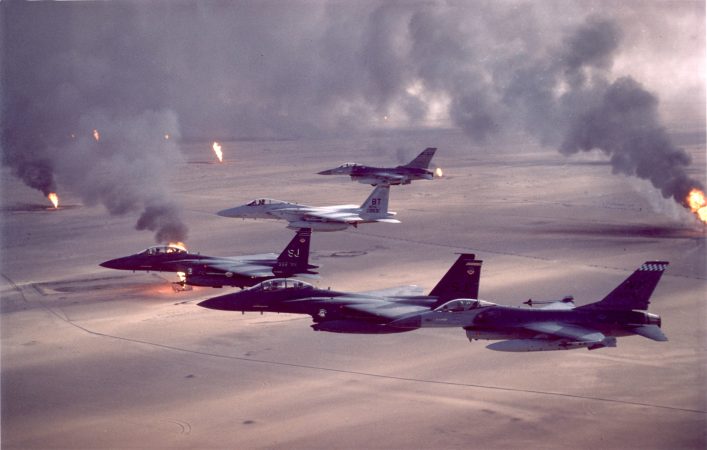It’s time to rethink the factors shaping U.S. defense policy.
The United States is presently confronted with the most significant national security challenge since its founding. In the past three years, the global deterrence networks that the United States developed to promote a world governed by laws rather than force have begun to falter.
The first sign of this was the fall of the Republic of Afghanistan, followed quickly by Russia’s invasion of Ukraine. More recently, Iran and its proxy forces launched attacks on Israel and commercial shipping in the Red Sea, and they continue to conduct low-level military operations against U.S. forces across the Middle East.
As these events unfolded, the People’s Republic of China dramatically increased its harrying actions against U.S. naval forces in the South China Sea and stepped up its preparations for a potential invasion of Taiwan. Whether by coordination or coincidence, these disparate military actions have worked synergistically to expose the fact that the United States no longer has the military wherewithal to support its deterrent posture globally.
As was the case when President Harry S. Truman commissioned the reassessment of America’s national security in 1950 that led to NSC-68 (United States Objectives and Programs for National Security), the country has entered a period in which its national objectives and military capabilities are severely misaligned. Our military can no longer fully maintain the rules-based international order that has long been the cornerstone of U.S. foreign policy. This has opened the way for our adversaries to seize upon opportunities to achieve their goals through violence. There is a significant chance that this cascading failure of deterrence will lead to a war between the United States and China.
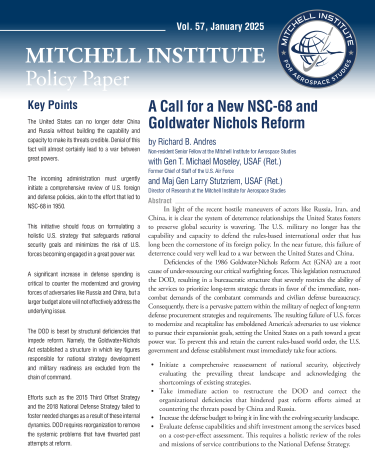
Richard B. Andres is a Non-resident Senior Fellow at the Mitchell Institute for Aerospace Studies, Gen. T. Michael Moseley, USAF (Ret.), was the 18th Air Force Chief of Staff, and Maj. Gen. Larry Stutzriem, USAF (Ret.), is Director of Research at the
Mitchell Institute.Download the entire report athttp://MitchellAerospacePower.org
Deter Potential Regional Hegemons
In the wake of World War II, the United States reduced its conventional power projection capabilities in the hope of returning to the peaceful isolation and small military budgets that characterized its foreign policy before and between the First and Second World Wars. However, as the United States drew down its forces, the Soviet Union became increasingly bellicose and began building and fielding its own nuclear capability. With war looming on the Korean Peninsula and the situation in Europe deteriorating rapidly, President Truman requested a strategic assessment of American national security. The result was NSC-68, a report of Truman’s National Security Council that diagnosed the emerging crisis and set a course for U.S. national security policy that persists today.
NSC-68 represented a radical change in priorities. The document began by establishing that the problem the United States faced was a rapidly changing balance of international power that threatened to pull the nation into a third world war or a nuclear conflict.
While the authors of NSC-68 argued that the world’s shifting balance of power was central to the problem, they also believed that ideology played a critical role. Like modern-day communist China, the Soviet Union’s autocratic system required absolute ideological control over its subjects. Thus, should Soviet expansionism succeed, the global system that would emerge would be inimical to America’s most closely held values.
The fear of violent regional hegemons that led to NSC-68 laid the cornerstone of modern U.S. deterrence. The United States would pay the high costs of making itself militarily strong, supporting the peaceful political and economic functioning of the free world, and fostering democratic change in the world’s leading autocracy. For the 40 years following its publication, NSC-68 provided the compass heading for U.S. foreign policy.
The authors’ decision to advocate for a powerful military was based on the firm conviction that the cost of failing to deter an autocratic great power would be significantly higher than the cost of maintaining a powerful military. Throughout the Cold War, the United States maintained relatively high levels of defense spending, rising as high as 14 percent of GDP in 1953. But, as the authors predicted, U.S. actions allowed the world to avoid a third world war or a nuclear conflict. Likewise, the report correctly anticipated that if the Soviet Union was unable to expand through the use of force, it would eventually collapse.
This analysis has clear parallels with today’s crisis. Importantly, American citizens of that era who lived through WWI and WWII understood that the cost of preventing war was preferable to the alternative—as the cost of lives, opportunities, and resources in a world war is catastrophic.
A Change in Priorities
When the Soviet Union ultimately began to disintegrate, the United States confronted two challenging decisions regarding its military. The first was whether to continue to maintain the substantial burden of supporting a first-class force. The second was whether to maintain a force oriented toward deterring regional hegemons or one aimed more at counterinsurgency and promoting democracy abroad.
When the Soviet Union fell, the Bush administration almost immediately published a new National Security Strategy that rejected a return to isolationism. The United States proved its commitment to these goals when, in 1991, it led an international coalition to defeat Iraq’s invasion of Kuwait.
Yet, over the next two decades, U.S. foreign policy underwent a series of profound changes. The United States began to use its military with increasing frequency for lesser contingencies to stabilize regions and, in some cases, support long-term nation-building activities. Throughout the period, DOD engaged in nearly constant small-scale contingencies in Somalia, Haiti, Bosnia, Serbia, Libya, Syria, Afghanistan, and Iraq, among other places. The Department of Defense increasingly paid the bill by postponing the recapitalization of its aging Cold War equipment. By the mid-2000s, much of the nation’s mainline military capabilities, originally developed during the Cold War, were operating decades beyond their planned retirement dates. By the late 2000s, readiness rates had dropped precipitously, leaving an increasingly large portion of America’s air and sea forces technologically or mechanically unable to operate in the likeliest major power contingencies.
In 2008, the debate over whether the United States should prioritize defense procurement for ongoing small wars or for deterring regional autocratic hegemons reached a tipping point. Driven by calls from U.S. Central Command, then-Secretary of Defense Robert Gates came down on the side of altering defense priorities to focus on the current conflict. In a strongly worded speech, he called out the Air Force Chief of Staff for preparing for future conventional conflict in nonpermissive environments, labeling it “Next-War-Itis.” He called for an even more rapid shift in priorities toward supplying forces for nation-building and away from building forces capable of deterring Russia and China.
In the decade that followed, DOD institutionalized this shift in priorities, with resources systemically transferred from programs that supported the long-term goal of deterring potential regional hegemons to those that supported the combatant commands’ immediate needs. Programs designed to fight peer competitors, often already years or decades behind schedule, were further delayed or canceled. Emblematic of this, but far from exceptional, was the Air Force’s nonstealthy B-52 bomber, which officially entered service in 1955 and, despite bitter protests by the Air Force, was programmed to remain at the center of America’s strategic bomber fleet until at least 2060—in service over 100 years.
The resources available to fight peers and, more generally, to prosecute conventional wars were harvested for use in expanding the day-to-day missions of combatant commands.
Goldwater-Nichols
In recent years, a growing chorus of defense leaders, including current Chairman of the Joint Chiefs of Staff (CJCS) Gen. Charles Q. Brown, former Commandant of the Marine Corps Gen. David H. Berger, former Deputy Secretary of Defense Robert Work, former Undersecretary of Defense for Policy Michèle Flournoy, and elected officials in the House and Senate have argued that the move away from preparing for future wars has less to do with strategy and more to do with organizational incentives embedded in the structure of DOD by the 1986 Goldwater-Nichols Act.
At the core of the problem is the recurring need for DOD to make difficult decisions about how to allocate limited defense dollars between current operations and preparing for the future. Before Goldwater-Nichols, the individuals responsible for making these hard decisions were mainly the chiefs of staff of the individual services. Chiefs were well-suited to make them because they were personally accountable for both short- and long-term outcomes. They were charged with both commanding ongoing military operations and advocating in Congress for the equipment their service would need in future wars.

But Goldwater-Nichols removed the service chiefs from this role. The National Security Act of 1947 had reorganized the military and delineated service missions, but DOD had evolved in the 40 years since and the services were increasingly partisan and had demonstrated significant problems collaborating in joint operations, undermining the military’s warfighting capability.
Removing the service chiefs from the chain of command and inserting regional combatant commanders instead to serve as the bridge between the President and front-line fighters was the solution offered by Goldwater-Nichols. In theory, the combatant commanders would be primarily concerned with effective joint operations rather than loyalty to any service.
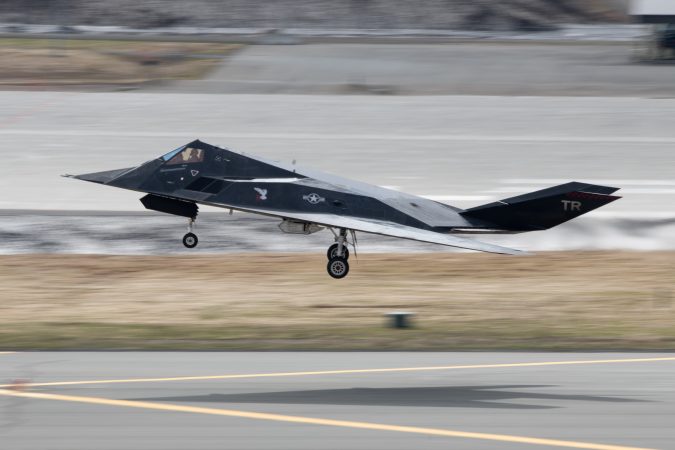
Unfortunately, the solution did not work. First, although the legislation removed the service chiefs from the chain of command, it did not place the Chairman of the Joint Chiefs of Staff in the new chain of command alongside or above the combatant commanders. In this system, influence over the combatant commands and services depends on the Chairman’s ability to cajole and persuade them to prioritize long-term and global planning needs, often at the expense of their own priorities and resources. In practice, this means that the Chairman’s ability to strategically shape defense procurement is far less effective than Goldwater-Nichols’ authors anticipated.
The second variable that undermined the department’s ability to make hard choices between current and future defense needs involved the use of joint task forces rather than the existing combatant command structures. This created a new construct in which regional combatant commanders were bypassed for combat missions. Practically speaking, this left combatant commanders mainly responsible for their command’s peacetime rather than combat missions.
Yet combatant commanders became the most important voices in the defense procurement process. This dynamic endures even after their exclusion from commanding combat missions by the new joint task force construct. This resulted in a persistent draw on defense dollars to fund a growing number of noncombat operations that too often did not contribute to an overarching strategy of preventing the rise of regional hegemons or deterring great power adversaries.
By circumventing national defense strategy and giving precedence to requests from combatant commands, DOD risks prioritizing immediate exigencies over the planning of ostensibly higher authorities. This not only results in suboptimal strategic outcomes but also actively contravenes the constitutional mandate to subordinate the military to elected civilian leadership in the executive and legislative branches of government.
Over the past decade, both civilian and military leaders at the Department of Defense have consistently identified the deficiencies of the 1986 Goldwater-Nichols Reform Act as the root cause of under-resourcing critical warfighting forces.
The Failure of the Third Offset Strategy
Over the past decade, China and Russia grew more powerful and militarily aggressive. While DOD officials issued dire warnings about increasing threats and tried twice to respond, both attempts failed because Congress chose not to increase the defense budget to match the requirements of DOD’s strategy. Likewise, Congress and DOD did not fix the perverse incentive system created by Goldwater-Nichols.
DOD’s first attempt at reform began in 2015, with the pursuit of the Third Offset Strategy, a comprehensive effort to maintain and extend the military’s competitive advantage against growing Chinese and Russian martial power through the innovative use of novel technologies to offset the numerical and geographical advantages of modernized and capable adversaries. In simple terms, the strategy sought to exploit the U.S. technological advantage to counter the growth in military capabilities of China, Russia, and others.
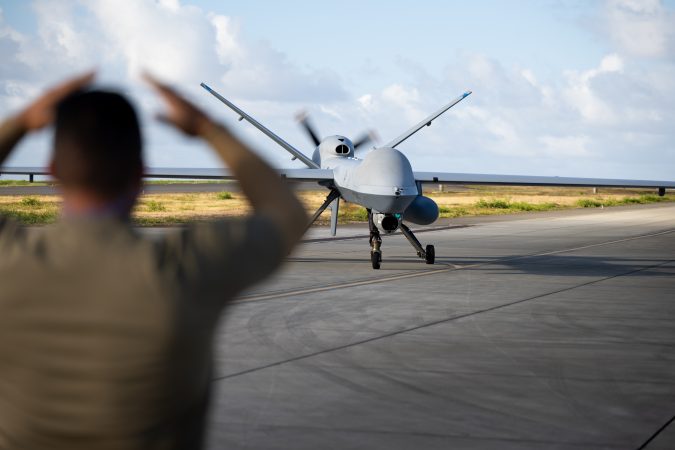
The strategy was based on the First and Second Offset Strategies, which the United States executed during the Cold War. These succeeded because, at the time, both DOD and industry responded quickly to meet the strategies’ requirements.
At the dawn of the Cold War, there had been an urgent need to develop intercontinental ballistic missiles (ICBM) to counter the USSR’s advantage in numbers and proximity to Western Europe. By prioritizing the project as part of the First Offset Strategy, DOD was able to accomplish one of history’s greatest technological achievements in a mere three years.
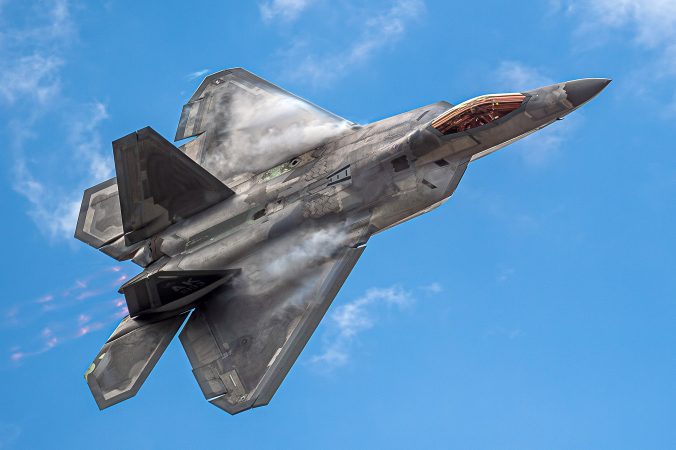
In the late 1970s, when U.S. forces suffered a vast numerical inferiority in conventional forces in Europe, it executed the Second Offset Strategy. This time, the goal was to use stealth, precision guidance, and networking to overcome the USSR’s larger force inventory. Once again, DOD was able to execute the strategy quickly. For instance, the F-117 stealth fighter progressed from initial concept to operational readiness in less than five years.
Despite the great efforts of the services and several innovative programs, a decade on it is hard to identify any single technology or weapon system in operation with significant implications for major power war or deterrence stemming from the Third Offset. DOD’s inability to replicate the success of previous offset strategies is unsurprising. Throughout the 1990s, Goldwater-Nichols systemically moved defense acquisition authority from military to civilian decision-makers—from the services to the secretariat—with concomitant changes in priorities and timelines. Where the military services prioritized combat in acquisition decisions, the centralized DOD culture post-Goldwater-Nichols reforms often prioritized bureaucratic processes, consensus, and an array of nonmilitary political priorities. This culture drastically increased timelines, costs, and overruns.
In short, the Third Offset Strategy likely failed due to a simple lack of funding and more serious organizational problems.
The 2018 Pivot to China
In 2018, the United States published a new National Security Strategy and National Defense Strategy (NDS) that officially focused defense on China rather than across the wide scope of threats highlighted in past strategies. This new focus on great power competition was replicated in the 2022 NDS and continues to guide policy today.
The rationale behind the 2018 NDS’s pivot to great power competition and focus on China was the same one that visionaries like Deputy Secretary of Defense Robert Work described when they advocated for the Third Offset Strategy. If an increasingly belligerent China could dominate the region by force and fear, it would become the regional hegemon and eventually dominate and displace the rules-based world order with an autocratic system more congenial to its own system of government.
One of the core concepts behind the 2018 National Defense Strategy centered on forming regional defense partnerships to counter China’s approach of singling out and targeting countries one at a time. Defense planners posited that if China were to invade Taiwan, for example, it would significantly weaken the confidence of regional allies and partners in the U.S. commitment to their safety and security, thereby diminishing their resolve to resist pressure from China. This concern mirrored those of NSC-68 from nearly 70 years earlier about the Soviet Union but emphasized the urgency of addressing China’s assertive foreign policy to prevent the unchecked spread of its expansionist goals.
While there was a good deal of bipartisan agreement in the defense community about the growing threat and need for reform, the writers of the new NDS faced two significant hurdles. The first was that they would have to execute that massive new requirement without an increase in funding. The second was that, even in the face of demands from the White House, the Joint Staff, and the services, the perverse organizational structure of DOD created by Goldwater-Nichols continued to frustrate attempts to refocus procurement on the capabilities needed to fight great power opponents.
The Pentagon adopted two approaches to attempt the execution of the ambitious 2018 National Defense Strategy without increasing defense spending. The first was to call for a variety of reforms to the organization of the DOD. The second was to move from a two-war to a one-war force-sizing policy focused on China. This signaled a major departure from the two-war construct established by the 1993 Bottom-Up Review, which dominated post-Cold War military thinking. While the attempt to reorganize DOD quickly collapsed under the weight of the Pentagon’s bureaucracy, the downgrade to a one-war construct was more successful.
The rationale for transitioning to a one-war planning framework was ostensibly to reallocate resources to Asia, thereby enhancing the credibility of U.S. deterrent forces within the region. This meant accepting greater risk because, as the Pentagon diverted resources from other regions, it diminished the credibility of U.S. deterrent promises to allies and partners in those theaters. The effectiveness of the revised strategy hinged on assumptions concerning the Pentagon’s capacity and readiness to execute the strategy, as well as the presumed incapacity of foreign adversaries to coordinate their actions to capitalize on new strategic windows of opportunity. Both sets of assumptions ultimately proved to be overly optimistic.
The strategy was meant to compel the Pentagon to shift away from its decades-old policy of prioritizing the immediate demands of combatant commands over the requirement to create forces capable of providing for their future needs. Yet, the move did not result in the intended balance between current and future missions. DOD’s organizational structure continues to systemically prioritize today’s combatant command requirements over the modernization and recapitalization needs of tomorrow’s combatant commanders.
This organizational misallocation of priority is not limited to short- versus long-term planning needs, but also service equities. The Indo-Pacific theater that is the focus of the new strategy necessitates a force composition that leans heavily toward naval, air, and space capabilities. It follows that implementing a China-focused strategy would require the Department to transfer resources from the Army’s budget to prioritize the Navy, Air Force, and Space Force budgets. The focus on counterinsurgency in the 2000s similarly increased the Army’s budget at the expense of Air Force recapitalization and modernization investments. In fact, the Army received over $1.3 trillion more than the Air Force between 2002 and 2021, an average of $66 billion more per year. Yet, such a decision today would require hard choices that Flournoy and others have described as impossible, given DOD’s consensus culture.
Instead, the service shares of the defense budget remain static, and DOD’s leadership continues to approve Army investments in duplicative capabilities, such as investing in $60 million to $70 million-a-shot long-range surface-to-surface missiles, fires that the Air Force could conduct for a fraction of the cost.
While the 2018 pivot failed to garner sufficient funds and fell afoul of the same organizational problem that had undermined previous efforts at reform, its biggest failure had nothing to do with budgets or organization. The principal assumption underlying the strategy was that the United States could safely move to a one-war construct and avoid increasing the defense budget because its adversaries in Europe, the Middle East, and Asia were not capable of synchronizing their actions to exploit this change in U.S. force planning. As of 2025, this assumption has proven incorrect.
A Way Forward
The United States is now faced with an impossible choice. It can reduce its foreign policy goals and commitments to bring them in line with its diminished military capabilities, or it can increase its military capabilities and capacity to bring them in line with its long-held goal of supporting a rules-based international system—one in which violence is not an acceptable means of resolving international disputes.
If the United States instead continues to attempt to deter China and Russia without building the capability and capacity to make its threats credible, adversaries will eventually call its bluff. Such a scenario will almost certainly lead to a war between great powers.
If the United States chooses to retain its diplomatic commitments, it must grow its military capability to meet them. This not only means increasing defense spending but also, importantly, making significant changes in the way DOD is organized and how it prioritizes its long- and short-term spending goals. But there is no longer time to spare. After decades of neglect, the country’s capability to fight conventional wars and deter major powers is anemic. While all the services reflect this neglect, the worst off is the U.S. Air Force, which today is the oldest, smallest, and least ready in its entire history.
The backbone of the nation’s bomber fleet, the B-52, just celebrated the 72nd anniversary of its first flight. The bulk of its fighter aircraft—F-15s and F-16s—were originally designed in the 1960s and 1970s, and they were first built during the Nixon, Ford, and Carter years. The Navy’s Ticonderoga-class cruisers and Los Angeles-class submarines were first commissioned in the 1970s and 1980s, respectively. The Army’s primary battle tank, the M1 Abrams, was initially deployed in the 1980s. Equally or more concerning, the programs Congress has initiated since the end of the Cold War to modernize the military with new high-tech capabilities are decades behind schedule and show no sign of accelerating.
Overcoming the organizational inertia that has allowed this to occur will require a comprehensive and assertive reevaluation of both procurement strategies and operational doctrines. This reevaluation must be accompanied by an increase in funding, targeted investments in emerging technologies, and streamlined decision-making processes to ensure rapid and effective modernization.
In short, the U.S. government and defense establishment must immediately take four actions:
- Initiate a comprehensive reassessment of national security, objectively evaluating the prevailing threat landscape. This initiative, akin to the effort that led to NSC-68 in 1950, should focus on formulating a holistic U.S. strategy that safeguards national security goals and minimizes the risk of U.S. forces becoming engaged in a war with China or Russia—or both.
- Take immediate action to restructure the Defense Department and correct the organizational deficiencies that hindered past reform efforts. This will entail, among other things, repositioning the service chiefs within the chain of command while taking steps to preserve the ability of U.S. forces to conduct joint operations. Congress must revise or supplant the Goldwater-Nichols Act with policies that better balance DOD’s immediate and long-term priorities.
- Increase the defense budget to bring it in line with the evolving security landscape. Constructing a military force capable of dissuading China and Russia from engaging in actions that may precipitate a major power conflict requires substantial funding increases. If the administration and Congress are unable or unwilling to increase defense spending enough to credibly deter China and Russia, it would have significant negative economic and security impacts on core U.S. interests in ways most American citizens would find unacceptable.
- Start evaluating defense capabilities with an eye toward shifting investment among the services based on a cost-per-effect assessment. Investing defense dollars wisely does not mean cutting or adding to budgets where most convenient or politically easy. Investment options should instead be weighed against each other based on desired battlespace effects, rooted in a strategy that poses a credible deterrent force able to overcome adversary military capabilities. This would require a tough-minded and comprehensive review of the roles and missions of service contributions to the strategy.
While the reforms described above will be difficult, they can either be made proactively or will become necessary in the event U.S. deterrence fails. It would be difficult to overstate the severity of the current crisis. If the United States does not change course quickly, the risk of war with China and possibly Russia and Iran will continue to increase. It is still possible to prevent this outcome, but doing so demands immediate and decisive action.

